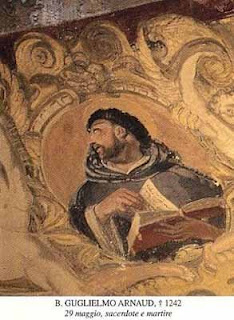History has not preserved information about Blessed Willaim's early life; however, we do know that in A.D. 1234 he and two other Dominicans were commissioned as inquistors by Pope Gregory IX to combat the heresy of Albigensianism in France. As Blessed William and his companions fought the heresy, they were driven from Toulouse, Narbonne, and several other French towns.
What follows is an account of Blessed William's martyrdom
After the death of Saint Dominic, the party of Count Raymond of Toulouse rose to power again. In a short time it regained possession of Toulouse and several armed strongholds nearby. When William Arnaud and his companions came into the vicinity, they found every gate closed against them. None of the cities under the command of Raymond's troops would allow them to come in, and, by order of the heretic commander, the citizens of Toulouse were forbidden under pain of death to supply the inquisitor's party with any food. They took refuge in a farmhouse outside of Avignonet and preached around the countryside for some time. Because they had some measure of success, the heretics intensified their efforts to entrap and kill the inquisitors.
The members of the commission realized that they were only one step from death. They might have escaped and gone safely to some other part of the country had they chosen to do so. Instead, they remained where obedience had assigned them, and at the end of May 1242, they were given a heavenly warning that they were about to receive the crown of martyrdom. William was absent from the rest of the group when the plot was formed to kill them. Being told of a vision of martyrdom by one of the brothers, he hurried back to rejoin his group. The heretics completed their plans to massacre the entire party.
Scheming carefully, they set the scene at the country castle of one of the wealthy members of their group. In order to make sure of getting the inquisitors into the trap, they sent word to William that a confirmed heretic of his acquaintance wished to abjure his heresy and return to the faith.
Knowing well that it was a trap, William still could not refuse to go. He and his eleven companions went, on the evening of the Ascension, May 28, to the castle of Count Raymond VII of Toulouse. The soldiers of Raymond were concealed in the great hall. They fell upon the helpless group and killed all but four of the members. These four were taken out by friends who had know about the plot and hurried to the church.
William Arnaud and Steven of Narbonne were murdered in the sanctuary of the church as they sang the Te Deum. This was a crime almost unparalleled in medieval times when the right of sanctuary was one of the few strongholds against barbarism. The bodies of the martyrs were thrown into a deep ravine, and rocks were rolled down on them. During the night, some hours after the martyrdom, bright lights radiating from the bodies of the martyrs brought the faithful to gather up the relics.
The church of Avignonet was placed under interdict because of the sacrilege, and for 40 years no Mass was said there. The doors remained closed. Finally, when the interdict was lifted, the bells rang of themselves, according to legend, to let people know that Avignonet was once more a member of the living Church.
There is a curious footnote to this story of martyrdom. Shortly after the interdict was lifted, there appeared one day on the steps of the church a fairly large statue of the Blessed Virgin. Who had put it there has never been discovered. It is difficult to see how anyone in such a small town could have successfully concealed a statue of that size, for small towns are notoriously poor places to hide secrets. The statue appeared on the steps in broad daylight, yet no one saw it being placed there. The people took it as a sign that they were forgiven for their part in the outrage, and also as a sign that they should rebuild the devotion to Our Lady, which the Dominicans had preached. The statue was named "Our Lady of Miracles," and they petitioned for a special feast in honor of their own Miracle lady.
Until very recently, a strange little ceremony was held in the Church of Our Lady of Miracles on every May 28. It was a night ceremony, in memory of the night martyrdom of William Arnaud and his companions, and it was called "The Ceremony of the Vow." Carrying lighted candles, the people proceeded across the entire width of the church on their knees, praying for forgiveness for the people who committed the massacre (Benedictines, Delaney, Dorcy). Blessed William Arnaud is invoked by people who suffer from neuralgia, in memory of a miracle of healing which he performed on one of the sisters of Prouille (Dorcy).













No comments:
Post a Comment